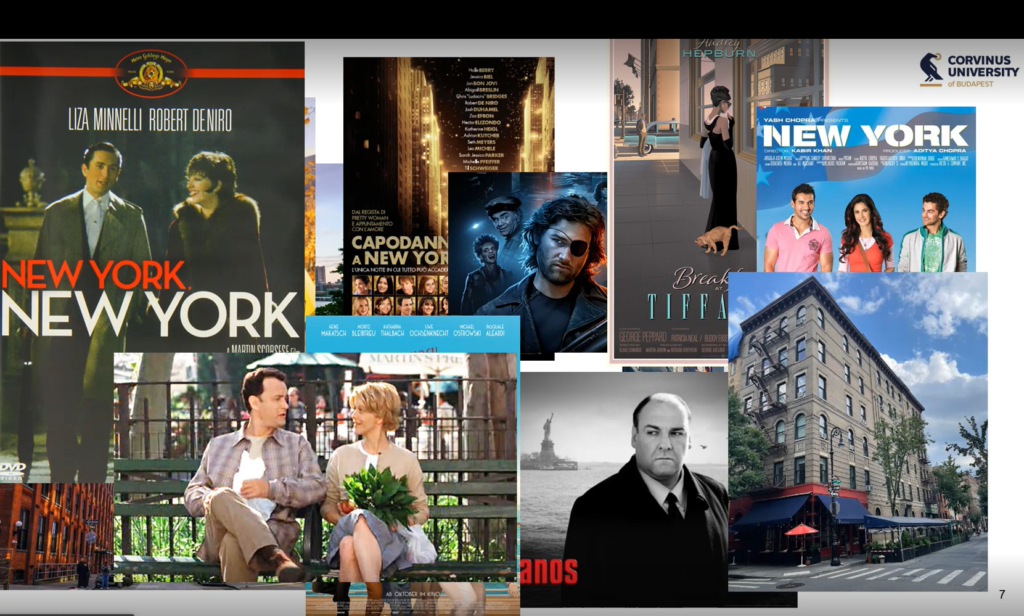From Carrie’s house to Teca’s pub – popular films attract tourists

‘Urban geography aspects of films and film production’ – this was the title of the on-line presentation delivered by dr. Anna Irimiás and organised by the Human Geography Department of the Hungarian Geographical Society and the Urban Development Department of the Corvinus, in the series of lectures on economic geography. The speaker presented the shooting locations of legendary and well-known films to the audience in pictures, and pointed out the role of film production in urban development and local economic recovery, mentioning a number of examples for its deliberate application.
A lot of people remember the film titled Roman Holiday, with the beautiful, elegant and young Audrey Hepburn in the leading role. Following the first showing of the film in 1953, Rome was associated with the term of vacation in the minds of American tourists, and that generated high revenues to the city. It also happened that a rural shooting location, which nobody had heard about before, made a previously almost unknown place famous, like in the case of the little town of Gubbio in the region of Umbria, which was placed on the mental map of the audience by the Don Matteo series. In the same way, a staircase in New York became famous and a popular location to take photos after the release of the Sex and the City series, because the main character of the series, Carrie Bradhsaw ‘lived’ in that house. In Oxford, an otherwise operating heritage location at the university became famous because it served as a shooting location of the Harry Potter films for a few months.
’Most of the images are created in our heads with the help of films, or nowadays videos on Tik-Tok or Instagram’, said the lecturer who has been studying this interesting topic for 15 years. Chinatown, Queens, Manhattan, the Central Park – with the lake where Tom Hanks was feeding the ducks in a film – are familiar and attractive places even to people who have never been to New York, and evoke certain emotions. ‘Although nerve cells in the human brain transmit electrochemical signals, and thoughts are born through neurotransmitters, we still perceive pictures and think in pictures’, explained the lecturer. But there are Hungarian examples, too, as the main character and one of the directors of the film The Pagan Madonna, which was shot at Balatonfüred and Tihany, has a statue on the lake side at Balatonfüred, and it has become a popular location to take photos.
However, we have not only pictures, but stories, too, in our heads, which are able to influence an individual’s emotions and mood, too, in relation to a city. A map of Amsterdam, which objectively depicts the grachts, the polders (territories taken from the sea) and the buildings is only one aspect. The other aspect is the relation between the environment and the emotions of the individual, which is examined by psychogeography associated with the names of Guy Debord and Kevin Lynch. You have to walk and ‘get drifted’ in a city to experience this. Reijnders Dutch researcher also found that geographical locations and objects allow us to cross the border of the city and imagination – said the lecturer.
Thus film tourism may bring popularity and high revenues for individual towns and regions. It is also true, of course, that investments in the film industry can be risky, as you never know in advance which film will be successful. So it is interesting to know who the film producing great powers are. It is logical that they are the big countries, where the internal markets are huge, such as China and India, because if only 1 per cent of the population of these countries will watch the film, that is already a huge number and huge profit. Actually, Nigeria is also a film ‘superpower’, as films and video series shot here are popular in a lot African countries, so after Hollywood and Bollywood, Nollywood has become a film superpower, too.
Thus films, TV series and videos are primary propaganda instruments, the tools of soft power, she said. The HBO series titled Game of Thrones (8 seasons, 73 episodes) was extremely popular, and the fans visit the shooting locations, the ‘sacred places’ – such as Dubrovnik – not because they are world heritage locations, but because they are the shooting locations of the series loved by many people. In 2021, Anna Irimiás and her colleagues asked 385 Hungarian fans about this topic, and it turned out that people felt a very strong motivation to visit these places.
The so-called Creative Cities Network was established by the UNESCO in 2004, and today it offers a cooperation platform to 300 cities in 90 countries in order to make local creative and cultural resources more creative. In the European Union, the cultural and creative sector presently provides 4.4 per cent of the GDP. From 2010 to 2019, more than 21 thousand films were produced in Europe.
In the discussion after the presentation, the TV series titled Our Little Village, which is very popular in Hungary, was also mentioned, as it has a similar impact on the village that served as its shooting location. Although the village in the series, Pajkaszeg, is a fictional name – the shooting location is actually Pilisszentlélek, a small village with 300 inhabitants in the Visegrád Hills –, the iconic location in the series, Teca’s pub does exist. Somebody from the audience said that he visited the village and the pub because of the series only. Another person noted that that rural places can be easily sold with a good film, mentioning Tüskevár, which was produced from a novel by István Fekete.
Katalin Török